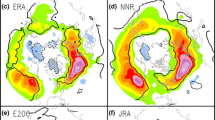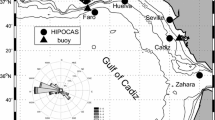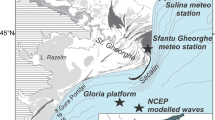Abstract
This article builds on the previous studies on storminess conditions in the northeast North Atlantic–European region. The period of surface pressure data analyzed is extended from 1881–1998 to 1874–2007. The seasonality and regional differences of storminess conditions in this region are also explored in more detail. The results show that storminess conditions in this region have undergone substantial decadal or longer time scale fluctuations, with considerable seasonal and regional differences. The most notable differences are seen between winter and summer, and between the North Sea area and other parts of the region. In particular, winter storminess shows an unprecedented maximum in the early 1990s in the North Sea area and a steady upward trend in the northeastern part of the region, while it appears to have declined in the western part of the region. In summer, storminess appears to have declined in most parts of this region. In the transition seasons, the storminess trend is characterized by increases in the northern part of the region and decreases in the southeastern part, with increases in the north being larger in spring. In particular, the results also show that the earliest storminess maximum occurred in summer (around 1880), while the latest storminess maximum occurred in winter (in the early 1990s). Looking at the annual metrics alone (as in previous studies), one would conclude that the latest storminess maximum is at about the same level as the earliest storminess maximum, without realizing that this is comparing the highest winter storminess level with the highest summer storminess level in the period of record analyzed, while winter and summer storminess conditions have undergone very different long-term variability and trends. Also, storminess conditions in the NE Atlantic region are found to be significantly correlated with the simultaneous NAO index in all seasons but autumn. The higher the NAO index, the rougher the NE Atlantic storminess conditions, especially in winter and spring.







Similar content being viewed by others
References
Alexander LV, Tett SFB (2005), Recent observed changes in severe storms over the United Kingdom and Iceland. Geophys Res Lett 32:L13704, doi:10.1029/2005GL022371
Alexandersson H, Schmith T, Iden K, Tuomenvirta H (1998) Long-term variations of the storm climate over NW Europe. Glob Atmos Ocean Syst 6:97–120
Alexandersson H, Tuomenvirta H, Schmith T, Iden K (2000) Trends of storms in NW Europe derived from an updated pressure data set. Clim Res 14:71–73
Bengtsson L, Hodges KI, Roeckner E (2006) Storm tracks and climate change. J Clim 19:3518–3543
Environment Canada (cited 2004) The National Archives System QC program checks for hourly SA’s. http://nadm.ontario.int.ec.gc.ca/Intranet/nadm/nas/quality_control/hourlies_e.htm
Gillett NP, Zwiers FW, Weaver AJ, Stott PA (2003) Detection of human influence on sea-level pressure. Nature 422:292–294
Gillett NP, Allan RJ, Ansell TJ (2005) Detection of external influence on sea level pressure with multi-model ensemble. Geophys Res Lett 32:L19714. doi:10.1029/2005GL023640
Gleason, BE, Compo GP, Matsui N, Yin X, Vose RS (2008) The integrated surface pressure databank (ISPD) Version 2.1, National Climatic Data Center, Asheville, NC, pp 1–12. ftp://ftp.ncdc.noaa.gov/pub/ispd/doc/ISPD2_1.pdf
Gulev SK, Zolina O, Grigoriev S (2001) Extratropical cyclone variability in the Northern Hemisphere winter from the NCEP/NCAR reanalysis data. Clim Dyn 17:795–809
Kendall MG (1955) Rank Correlation Methods. Charles Griffin, 196pp
Hess A, Iyer H, Malm W (2001) Linear trend analysis: a comparison of methods. Atmos Environ 35:5211–5222
Hirsch RM, Slack JR (1984) A nonparametric trend test for seasonal data with serial dependence. Water Resour Res 20:727–732
Hirsch RM, Slack JR, Smith RA (1982) Techniques of trend analysis for monthly water quality data. Water Resour Res 18:107–121
Hurrell JW (1995) Decadal trends in the North Atlantic Oscillation: regional temperatures and precipitation. Science 269:676–679
Hurrell JW, van Loon H (1997) Decadal variations in climate associated with the North Atlantic oscillation. Climatic Change 36:301–326
Jung T, Hilmer M, Ruprecht E, Kleppek S, Gulev SK, Zolina O (2003) Characteristics of the recent eastward shift of interannual NAO variability. J Clim 16:3371–3382
Leckebusch GC, Ulbrich U (2004) On the relationship between cyclones and extreme windstorms over Europe under climate change. Glob Planet Change 44:181–193
Leckebusch GC, Koffi B, Ulbrich U, Pinto JG, Spangehl T, Zacharias S (2006) Analysis of frequency and intensity of winter storm events in Europe on synoptic and regional scales from a multi-model perspective. Clim Res 31:59–74
Mann HB (1945) Non-parametric tests against trend. Econometrica 13:245–259
Matulla C, Schoener W, Alexandersson H, von Stroch H, Wang XL (2008) European Storminess: Late nineteenth century to present. Clim Dyn 31:125–130. doi:10.1007/s00382-007-0333-y
McCabe GJ, Clark MP, Serreze MC (2001) Trends in Northern Hemisphere surface cyclone frequency and intensity. J Clim 14:2763–2768
Pinto JG, Ulbrich U, Leckebusch GC, Spangehl T, Reyers M, Zacharias S (2007) Changes in storm track and cyclone activity in three SRES ensemble experiments with the ECHAM5/MPI-OM1 GCM. Clim Dyn 29:195–210
Schmith T (1995) Occurrence of severe winds in Denmark during the past 100 years. In: Proceedings of the sixth international meeting on statistical climatology, pp 83–86
Schmidt H, von Storch H (1993) German Bight storms analyzed. Nature 365:791
Schmith T, Alexandersson H, Iden K, Tuomenvirta H (1997) North Atlantic–European pressure observation 1868–1995 (WASA dataset 1). Technical Report 97-3, Danish Meteorological Institute, Copenhagen, Denmark
Schmith T, Kaas E, Li T-S (1998) Northeast Atlantic winter storminess 1875–1995 re-analyzed. Clim Dyn 14:529–536
Trenberth KE et al (2007) Observations: surface and atmospheric climate change. In: Solomon S et al (eds) Climate change 2007: the physical science basis. Contribution of Working Group I to the Fourth Assessment Report of the Intergovernmental Panel on Climate Change. Cambridge University Press, New York, USA, 944pp
Ulbrich U, Christoph M (1999) A shift of the NAO and increasing storm track activity over Europe due to Anthropogenic Greenhouse Gas Forcing. Clim Dyn 15:551–559
Ulbrich U, Pinto JG, Kupfer H, Leckebusch GC, Spangehl T, Reyers M (2008a) Northern Hemisphere storm tracks in an ensemble of IPCC climate change simulations. J Clim 21:1669–1679
Ulbrich U, Leckebusch GC, Pinto JG (2008b) Extra-tropical cyclones in the present and future climate: a review. Theor App Climatol (accepted)
Uppala SM and co-authors (2005) The ERA-40 re-analysis. Quart J Roy Meteor Soc 131:2961–3012
Wang XL (2008a) Accounting for autocorrelation in detecting mean shifts in climate data series using the penalized maximal t or F test. J App Meteor Climatol 47:2423–2444. doi:10.1175/2008JAMC1741.1
Wang XL (2008b) Penalized maximal F test for detecting undocumented mean shift without trend change. J Atmos Oceanic Technol 25:368–384. doi:10.1175/2007/JTECHA982.1
Wang XL, Feng Y (2007) RHtestV2 User Manual. http://cccma.seos.uvic.ca/ETCCDMI/software.shtm (published online). Climate Research Division, Science and Technology Branch, Environment Canada, Toronto, Ontario, Canada. 19 pp
Wang XLL, Swail VR (2001) Changes of extreme wave heights in Northern Hemisphere Oceans and related atmospheric circulation regimes. J Clim 14:2204–2221
Wang XLL, Swail VR, Zwiers FW (2006a) Climatology and changes of extra-tropical cyclone activity: comparison of ERA-40 with NCEP/NCAR Reanalysis for 1958–2001. J Clim 19:3145–3166. doi:10.1175/JCLI3781.1
Wang XLL, Wan H, Swail VR (2006b) Observed changes in cyclone activity in Canada and their relationships to major circulation regimes. J Climate 19(6):896–915. doi:10.1175/JCLI3664.1
Wang XLL, Swail VR, Zwiers FW, Zhang X, Feng Y (2008) Detection of external influence on trends of atmospheric storminess and northern oceans wave heights. Clim Dyn (in press). doi:10.1007/s00382-008-0442-2
WASA Group (1998) Changing waves and storms in the Northeast Atlantic? Bull Am Meteor Soc 79(5):741–760
Acknowledgments
The authors are very grateful to Dr. Gil Compo and other members of GCOS/WCRP AOPC/OOPC (Atmosphere/Ocean Observation Panel for Climate) Working Group on Surface Pressure for providing us with the Integrated Surface Pressure Databank, which includes all the pressure data we analyzed in this study. The authors wish to thank Mr. Tommy Jang and Ms. Hui Wan for their help in downloading and extracting the data from the database. The authors also wish to acknowledge Mr. Torben Schmith of Danish Meteorological Institute for providing Val R. Swail his FORTRAN codes for calculating geostrophic wind speeds from pressure triangles, which we have modified slightly and used in this study. The authors also wish to thank Drs. Xuebin Zhang and Seung-Ki Min for their useful internal review of an earlier version of this manuscript, and the two anonymous reviewers for their helpful review comments.
Author information
Authors and Affiliations
Corresponding author
Appendices
Appendix A: Erroneous/suspicious SLP values
For any sea level pressure (SLP) series {P i } (i = 1,2,…,N), if |P i-1−P i | > 20 hPa and |P i+1−P i | > 20 hPa, the ith observation P i is considered a suspicious value. The 20 hPa threshold was selected considering the typical intervals between two consecutive observations in the early period (typically 8 h on average, i.e., three observations per day) and the limits for pressure tendency check used by Environment Canada [including 14.9 hPa (5 h)−1 and 16.9 hPa (6 h)−1; Environment Canada 2004]. The segment of observations, {P i −5,P i −4,…,P i ,…,P i + 4,P i + 5}, is checked against the corresponding segment of observations at the available nearest stations (e.g., Aberdeen is checked against Bergen and Torshavn), to determine whether the suspicious value is erroneous or not. Indeed, some of these suspects turn out to be true SLP values (e.g., those shown in Fig. 7) and are thus kept unchanged, while others are apparently erroneous. As a result, a total of 45 erroneous/suspicious values were identified; all of which are shown in Fig. 8, in comparison with the corresponding observations available at two nearest stations (only one station available in some cases). As detailed in Table 5, these values are either set to missing or corrected when possible. Most of these suspicious values are seen in the early period of the record (mostly in the late 19th century).
The same as in Fig. 7 but these suspicious SLP values (i.e., the outliers in the solid curves) are most likely erroneous and hence are set to missing or corrected when possible (see Table 5)
Note that the exclusion/correction of the suspicious SLP values listed in Table 5 makes a few outliers disappear, for example, the few outliers that show very high summer storminess around 1880s in Fig. 9b are not seen in Fig. 4b. However, the general characteristics of the decadal or longer time scale storminess variability are not significantly affected by the exclusion/correction (also see Figs. 4b, 9b). This is not surprising because the exclusion/correction of random errors are not expected to bias the results systematically.
Appendix B: Calculation of geostrophic wind speeds
For each pressure triangle, the geostrophic wind speeds (also referred to as geo-winds) are calculated from instantaneous SLP values for the same hour at the three sites that form the triangle (say site 1, 2, and 3). Let P 1, P 2, and P 3 denote the three instantaneous SLP values of the same hour at the three sites (site 1, 2, and 3, respectively). Following Schmith (1995), the geostrophic wind speed is calculated as
with components
where ρ is the density of air, f the Coriolis parameter, and a and b represent respectively the zonal and meridional pressure gradients and are calculated by fitting a plane to the three SLP values P 1, P 2, and P 3. Specifically, the three SLP values determine unique constants a, b, and c in the following set of equations (Schmith 1995):
where R is the radius of the earth, and λ i and ϕ i are the longitude and latitude (in arch degrees) of site i at the time of observation, respectively (X i and Y i are the Cartesian coordinates). In this study, we set ρ = 1.25kg/m3 and R = 63,78,100 m, and used the average of f over the three sites [\(f=2 \Omega \sin \phi\) at the latitude ϕ, where Ω = 2π/(24 × 3600) is the rotation rate of the earth (in arch degree per second)].
Rights and permissions
About this article
Cite this article
Wang, X.L., Zwiers, F.W., Swail, V.R. et al. Trends and variability of storminess in the Northeast Atlantic region, 1874–2007. Clim Dyn 33, 1179–1195 (2009). https://doi.org/10.1007/s00382-008-0504-5
Received:
Accepted:
Published:
Issue Date:
DOI: https://doi.org/10.1007/s00382-008-0504-5







